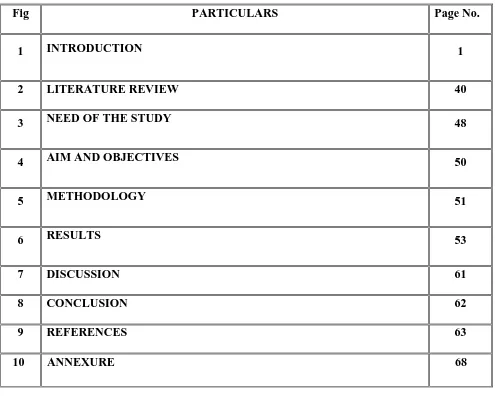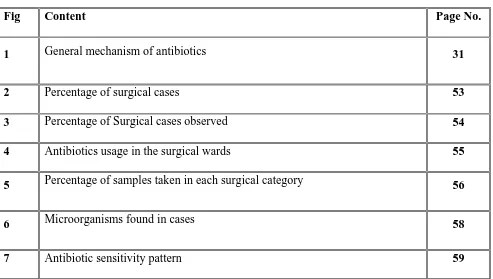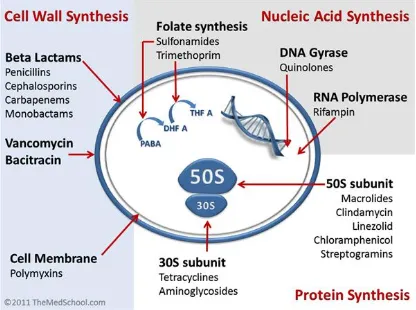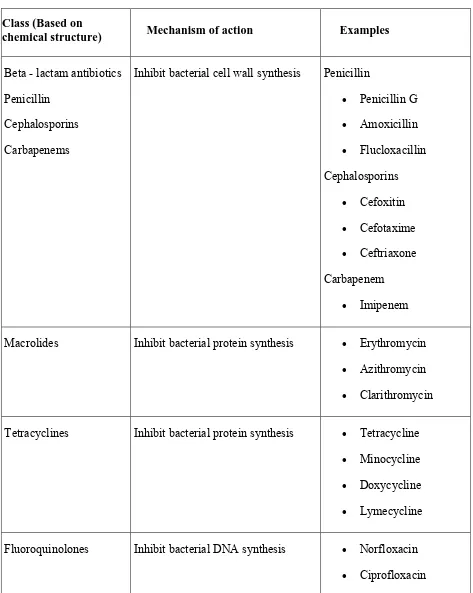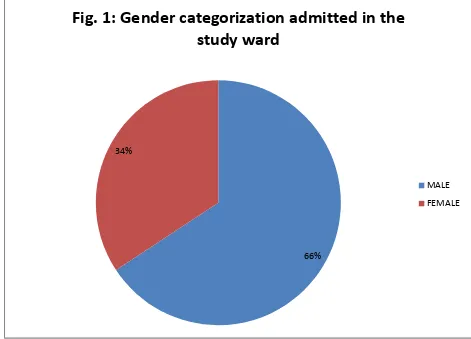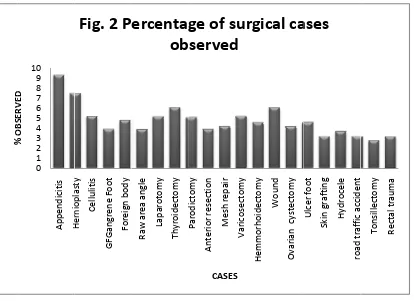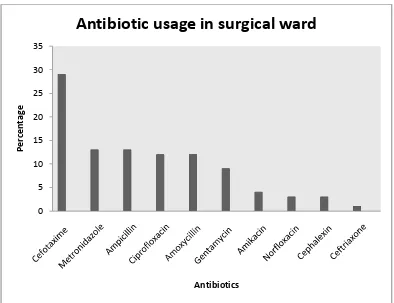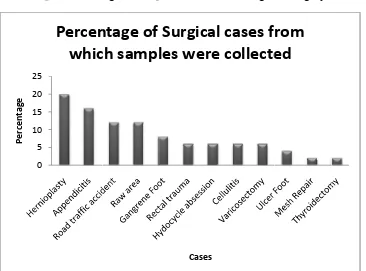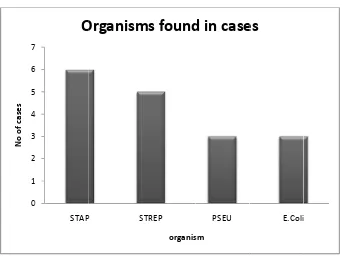A STUDY ON THE ANTI-BIOTIC SENSITIVITY PATTERN IN THE POST - OPERATIVE WARDS OF A TERTIARY CARE
HOSPITAL IN ERODE
Dissertation submitted to
The Tamil Nadu Dr. M.G.R. Medical University, Chennai-32
In partial fulfillment of the award of the degree of MASTER OF PHARMACY IN
PHARMACY PRACTICE
Submitted by Reg.No.26103187
Under the Guidance of
Mr. N. Venkateswaramurthy, M.Pharm.
DEPARTMENT OF PHARMACY PRACTICE J.K.K. NATTRAJA COLLEGE OF PHARMACY
C
EVALUATION CERTIFICATE
This is to certify that the dissertation work entitled “A study on the Anti -biotic Sensitivity Pattern in the Post - Operative wards of a Tertiary Care Hospital in Erode” submitted by the student bearing [Reg. No: 26103187] to “The Tamil Nadu Dr. M.G.R. Medical University”, Chennai, in partial fulfillment for the award of Degree of Master of Pharmacy in Pharmacy Practice was evaluated by us during the examination held on………..……….
CERTIFICATE
This is to certify that the work embodied in this dissertation entitled “A study on the Anti-biotic Sensitivity Pattern in the Post - Operative wards of a Tertiary Care Hospital in Erode” submitted to “The Tamil Nadu Dr. M.G.R. Medical University”, Chennai, in partial fulfillment to the requirement for the award of Degree of Master of Pharmacy in Pharmacy Practice, is a bonafide work carried out by Mr. P.Balasubramaniam, [Reg.No.26103187] during the academic year 2012-2013, under the guidance and supervision of Mr. N. Venkateswaramurthy, M. Pharm., Professor and Head, Department of Pharmacy Practice, J.K.K. Nattraja College of Pharmacy, Komarapalayam.
Place: Komarapalayam Dr.R.SambathKumar M.Pharm., Ph.D.., Date: Professor & Principal,
J.K.K. Nattraja College of Pharmacy.
CERTIFICATE
This is to certify that the work embodied in this dissertation entitled “A study on the Anti-biotic Sensitivity Pattern in the Post - Operative wards of a Tertiary Care Hospital in Erode” submitted to “The Tamil Nadu Dr. M.G.R. Medical University”, Chennai, in partial fulfillment to the requirement for the award of Degree of Master of Pharmacy in Pharmacy Practice, is a bonafide work carried out by Mr. P.Balasubramaniam, [Reg.No.26103187] during the academic year 2012-2013, under my guidance and direct supervision in the Department of Pharmacy Practice, J.K.K. Nattraja College of Pharmacy, Komarapalayam.
Mr. N. VENKATESWARAMURTHY, M.pharm, Professor & Head,
Department of Pharmacy Practice, J.K.K. Nattraja College of Pharmacy, Komarapalayam-638183,
DECLARATION
I do here by declared that the dissertation entitled “A study on the Anti-biotic Sensitivity Pattern in the Post - Operative wards of a Tertiary Care Hospital in Erode”
submitted to “The Tamil Nadu Dr. M.G.R Medical University”, Chennai, for the partial
fulfillment of the degree of Master of Pharmacy in Pharmacy Practice, is a bonafide research work has been carried out by me during the academic year 2012-2013, under the guidance and
supervision of Mr. N. Venkateswaramurthy, M.pharm., Professor & Head, Department of Pharmacy Practice, J.K.K. Nattraja College of Pharmacy , Komarapalayam .
I further declare that, this work is original and this dissertation has not been submitted previously for the award of any other degree, diploma, associate ship and fellowship or any other similar title. This information furnished in this dissertation is genuine to the best of my
knowledge.
Place : Komarapalayam P.Balasubramaniam
A
ACKNOWLEDGEMENT
I express whole hearted gratitude to my guide Mr. N.Venkateswaramurthy, M.Pharm.
Professor and Head, Department of Pharmacy Practice, for suggesting solution to problems faced by me and providing indispensable guidance, tremendous encouragement at each and every step of this dissertation work. Without his critical advice and deep-rooted knowledge, this work would not have been a reality.
I am proud to dedicate my deep sense of gratitude to the founder, (Late) Thiru J.K.K. Nattaraja Chettiar, providing us the historical institution to study.
My sincere thanks and respectful regards to our reverent Chairperson Smt. N.
Sendamaraai, B.Com., Managing Director Mr. S. Omm Sharravana, B.Com., LLB., and
Executive Director Mr. S. Om Singarravel, B.E., M.S., J.K.K. Nattraja Educational Institutions, Komarapalayam for their blessings, encouragement and support at all times.
It is most pleasant duty to thank for our beloved Principal Dr. Mr. R.SambathKumar M.Pharm., Ph.D.,., J.K.K.Nattraja College of Pharmacy, Komarapalayam for ensuring all the
facilities were made available to me for the smooth running of this project.
It is my privilege to express deepest sense of gratitude towards to Dr.
Mr.Lionalraj MS., DO., FRCS., Agarwal Eye Hospital, Tirunelveli for providing all
facilities, information and a good guidance to me for the completion of this project work.
My sincere thanks to N. Venkateswaramurthy, M.Pharm., Professor and
Head, Department of Pharmacy Practice. Dr. L.Panayappan, M.Pharm.,Ph.D., Assistant
Professor, Mrs. S. Thangamani M.Pharm., Lecturer, Department of Pharmacy Practice, Mrs
K. Krishna Veni M.Pharm., Lecturer, Department of Pharmacy Practice, Mrs Christy John
M.Pharm Lecturer, Department of Pharmacy Practice and Mr Anton Vinoth M.Pharm
My sincere thanks to Professor Mr. R. Sambath Kumar M.Pharm., Ph.D., Professor and Head, Department of Pharmaceutics, Mrs. S. Bhama, M.Pharm., Assistant Professor, Mr. M. Senthilkumr, M.Pharm., Assistant Professor, Mr. R. Kanagasabai, B. Pharm.
M.Tech., Assistant Professor, Mr. K. Jaganathan, M.Pharm., Lecturer, Department of
Pharmaceutics Mr C. Kannan M.Pharm., Lecturer, Department of Pharmaceutics and Mr
Kamalakannan M.Pharm., Lecturer, Department of pharmaceutics for their valuable help
during my project.
It is my privilege to express deepest sense of gratitude toward Dr. P. Sivakumar, M.pharm., Ph.D., Professor & Vice Principal, Department of Pharmaceutical
chemistry, Mr. M. Vijayabaskaran, M.Pharm., Assistant Professor, Lecturer, Department of
Pharmaceutical chemistry, Mr S.V. Arunachalam M.Pharm., Lecturer Department of Pharmaceutical chemistry and Mrs S. Gomathi M.Pharm., Lecturer, Department of Pharmaceutical chemistry, for their valuable suggestions and inspiration.
My sincere thanks to Mr. V. Sekar, M.Pharm., Professor and Head, Department of
Analysis, Mr. Senthilraja, M.Pharm., Assistant Professor, Mr. D. Boopathy,
M.Pharm., Assistant Professor, and Mr. S. Jayaseelan, M.Pharm., Assistant Professor,
Department of Pharmaceutical Analysis for their valuable suggestions.
My sincere thanks to Dr. S. Sureshkumar, M.Pharm., Ph.D., Professor and Head,
Department of Pharmacognosy and Mr. P.Balasubramaniam, M.Pharm., Lecturer, Department of Pharmacognosy for their valuable suggestions during my project work.
My sincere thanks to Mr. V. Rajesh, M.Pharm., Assistant Professor & Head, Department
of Pharmacology, Mrs. M. Sudha, M.Pharm., Lecturer, Department of Pharmacology, Mrs
Kavitha M.Pharm., Lecturer, Department of Pharmacology for their valuable suggestions
during my project work.
I greatly acknowledge the help rendered by Mrs. K. Rani, Office Superintendent, Mr. K. Sakthivel, Clerical Assistant, Miss. Prabha, Mrs. V. Gandhimathi, M.A.,
I owe my thanks to all the technical and non-technical staff members of the institute for their precious assistance and help.
Last, but nevertheless, I am thankful to my lovable parents and all my friends for their co-operation, encouragement and help extended to me throughout my project work.
P.Balasubramaniam
Reg.No:26103187
TABLE OF CONTENTS
S.NO. CONTENTS PAGE NO.
01 INTRODUCTION 1 - 12
02 LITERATURE REVIEW 13 - 20
03 NEED FOR THE PRESENT STUDY 21 - 22
04 AIM AND OBJECTIVES 23
05 METHODOLOGY 24 - 25
06 RESULTS 26 - 29
07 DISCUSSION 30
08 CONCLUSION 31
09 REFERENCES 32 - 35
CONTENTS
Fig PARTICULARS Page No.
1 INTRODUCTION 1
2 LITERATURE REVIEW 40
3 NEED OF THE STUDY 48
4 AIM AND OBJECTIVES 50
5 METHODOLOGY 51
6 RESULTS 53
7 DISCUSSION 61
8 CONCLUSION 62
9 REFERENCES 63
10 ANNEXURE 68
LIST OF TABLES
S.No CONTENT Page No.
1 The main microorganisms causing infections 2
2 Classification of antibiotics based on mechanism 31
3 Classification of antibiotics based on structure 36
4 Percentage of samples taken in each surgical category 56
5
Antibiotics prescribed in various surgical cases where incision swabs
were taken 57
6 Organisms found in cases 58
7 Sensitivity pattern of antibiotics with different microorganisms 59
LIST OF FIGURES
Fig Content Page No.
1 General mechanism of antibiotics 31
2 Percentage of surgical cases 53
3 Percentage of Surgical cases observed 54
4 Antibiotics usage in the surgical wards 55
5 Percentage of samples taken in each surgical category 56
6 Microorganisms found in cases 58
1
1. INTRODUCTION
1.1. An introduction about infection
An infection is caused by the invasion of foreign cells, like bacteria in humans
that cause harm to the host organism. Generally the host organism is considered
“colonized” by cells that don’t belong to it. These foreign cells must be harmful to the
host organism in order for the colonization to be considered an infection1.
Numerous agents can cause an infection. Not only bacteria, but also viruses,
parasites, and fungi can create problems for a host organism. Sometimes these
non-host cells actually work in conjunction to keep infection from occurring.
Infectious diseases, also known as transmissible diseases or communicable
diseases, comprise clinically evident illness (i.e., characteristic medical signs and/or
symptoms of disease) resulting from the infection, presence and growth of pathogenic
biological agents in an individual host organism. In certain cases, infectious diseases
may be asymptomatic for much or even all of their course in a given host. In the latter
case, the disease may only be defined as a "disease" (which by definition means an
illness) in hosts who secondarily become ill after contact with an asymptomatic
carrier. An infection is not synonymous with an infectious disease, as some infections
do not cause illness in a host.
Infectious diseases are sometimes called "contagious" when they are easily
transmitted by contact with an ill person or their secretions (e.g., influenza). Thus, a
contagious disease is a subset of infectious disease that is especially infective or easily
1. The main micro organisms causing infections areas follows 2
Name Living Conditions Examples Prevention Cure
VIRUSES Unable to live outside other cells. May infect prokaryotes and/or eukaryotes. Replicates inside host cell by coding (with viral nucleic acid) for new viral synthesis there.
Bacteriophages, Plant mosaic viruses, HIV, Herpes, Influenza, Hepatitis
Good personal hygiene. Some immunization(e.g. 'flu, polio)
NOT antibiotics. Immune system fights viruses. Recently, some antiviral drugs are developed.
BACTERIA Ubiquitous. In almost all environmental niches.
Most are non pathogens.Pathogenic bacteria:
Cause disease in eukaryotes. Classified by shape
(spheres, rods, spirals). Classified by chemistry
(eg Gram +/-) Classified by structures (cilia, flagella) Some produce destructive toxins.
Streptococcus, Salmonella,
Staphylococcus, Escherichia coli (E. coli) Mycobacterium tuberculosis, Clostridium tetani
Good personal hygiene.
Immunisation (e.g. TB), Public
sanitation, Surgical aseptic techniques.
FUNGI Yeasts - Unicellular, divide by binary fission or budding. Can exist as spores.Moulds - Filamentous mat of thread-like hyphae produces a mycelium. Fruiting bodies produce spores. (Some pathogenic fungi can exist as either of the above forms, depending on the environment.)
Candida (-> thrush) Trichophyton (-> tinea) Aspergillus (-> pneumonia or asthma)
Good personal hygiene. Various
anti-fungal drugs.
PARASITES Either ectoparasites (outer surfaces of host) or endoparasites (inside host's body). Many have complex life cycles which include a period away from humans and a time in or on humans. Many have specialised structures for attachment to humans either to prevent dislodgment or obtain nutrients or both. VECTOR = living transmitter of disease (e.g. mosquito -> malaria) RESERVOIR = source of parasite in biotic environment (e.g. contaminated soil or water).
Malaria, Dysentery, Liver fluke, Intestinal worms, Schistoma, Fleas, Ticks, Lice
Good personal hygiene.Public sanitation.Break
life-cycle.Cook meat before eating. Some insecticides. Some
drugs.Surgery to remove
26
1.2 Epidemiology of Infection 2
When bacteria infect an ordinarily sterile site, they present a serious medical condition,
even if they are not resistant to hosts, including other hospital patients, hospital workers, family
members, or schoolmates. The relative importance of these host reservoirs as a source of
infection probably declines as a function of proximity to the focal host; the most likely sources
are the patients themselves, followed by health care workers, other hospital patients, and family
members. The bacteria are transmitted by direct contact, such as touching or sneezing, or indirect
contact through an intermediate contaminated object. For example, health care workers can be
carriers, or they may be vectors who move bacteria among patients or from contaminated objects
in a patient’s room. The objects that surround individuals, including furniture and food and
water, can become contaminated. Medical devices area particularly important source of
infections: they bring a potentially contaminated surface into contact with living tissue. One
problem with medical devices is that their wet surfaces facilitate the growth of biofilms which
can help facilitate gene exchange and persistence, protect bacteria from antibiotics, and so
provide a natural refuge and gentle exposure that may become important in the evolution of
resistance. A potential source of antibiotic resistance in environmental bacteria is the sewage
effluent from hospitals and long-term care facilities, which contains large numbers of resistant
bacteria. Large amounts of antibiotics are also used in agriculture for prophylaxis or as
nutritional supplements, and antibiotic-resistant bacteria can remain in meat through the abattoir
and retail (Witte 1998). Most meat is properly cooked in the home or in restaurants, but
uncooked meat can cross-contaminate raw foods during preparation. This is a potentially
important source of exposure and perhaps colonization. Like hospital sewage, the effluent from
27
1.3 Surgical site infection(SSI) 3
Definition
Surgical site infections defined as the infections that occur up to 30 days after surgery (or up to
one year after surgery in patients receiving implants) and affecting either the incision or deep
tissue at the operation site. Despite improvements in prevention, SSIs remain a significant
clinical problem as they are associated with substantial mortality and morbidity and impose
severe demands on healthcare resources. The incidence of SSIs may be as high as 20%,
depending on the surgical procedure, the surveillance criteria used, and the quality of data
collection. In many SSIs, the responsible pathogens originate from the patient's endogenous
flora. The causative pathogens depend on the type of surgery; the most commonly isolated
organisms are Staphylococcus aureus, coagulase-negative staphylococci, Enterococcus spp. and
Escherichia coli. Numerous patient-related and procedure-related factors influence the risk of
SSI, and hence prevention requires a ‘bundle’ approach, with systematic attention to multiple
risk factors, in order to reduce the risk of bacterial contamination and improve the patient's
defences. The Centers for Disease Control and Prevention guidelines for the prevention of SSIs
emphasise the importance of good patient preparation, aseptic practice, and attention to surgical
technique; antimicrobial prophylaxis is also indicated in specific circumstances. Emerging
technologies, such as microbial sealants, offer the ability to seal and immobilize skin flora for the
duration of a surgical procedure; a strong case therefore exists for evaluating such technologies
28
Surgical site infections (SSIs) are linked to a major cause of patient injury and death and
consume substantial health care resources. A large percentage of the number of surgical site
infections (40% - 60%) is thought to be preventable and as such, characterized as a "never event"
medical error. Surgical site infection rates have been cited in the literature as occurring in
2%-5% of patients after clean extra-abdominal surgeries and up to 20% of patients undergoing
intra-abdominal procedures. It is difficult to identify nosocomial infections in patients who have been
discharged.
1.3.1 Classifications of Surgical Site Infections 4
They are classified as either incisional or organ/space infections. Incisional infections are
subdivided for those involving only the skin and subcutaneous tissue and for those involving
deeper soft tissue. Surveillance can include reviewing patients receiving antibiotic therapy for
any reason within the defined period of time after a surgical procedure.
a) Superficial Incisional Infections:
Infection involving only the skin or subcutaneous tissue of the incision and one or more of the following:
¾ Purulent drainage from the superficial incision with or without laboratory confirmation.
¾ Organisms confirmed by culture from either an aseptically fluid or tissue from the superficial incision.
¾ One or more signs of infection (pain/tenderness, localized swelling, redness or heat) and the superficial incision are deliberately opened by the surgeon unless the incision is culture-negative.
29
b) Deep Incisional Infections:
Infection involving deep soft tissue of the incision such as facial and muscle layers and one or
more of the following:
¾ Purulent drainage from the deep incision but not from the organ or space component of
the surgical site.
¾ The deep incision spontaneously separates or is deliberately opened by a surgeon
when the patient has one or more of the signs of infection (fever over 38ºC, localized pain
or tenderness) unless the site is culture-negative.
¾ A surgeon or attending physician diagnoses a deep incision surgical site infection.
c) Organ/Space Infections
Involves any part of the body, for example organs or spaces, other than the incision, which was
opened or manipulated during the procedure and one or more of the following:
¾ Purulent drainage from a drain that is placed through a stab wound into the organ/ space.
¾ Organisms confirmed by culture from either an aseptically obtained fluid or tissue from
the organ/space.
1.3.2. Epidemiology of surgical site infection5
Surgical site infections contribute significantly to the morbidity and mortality of the individual
patient and impose a burden on the health care resources of the community. With the shift
30
are being diagnosed after discharge. There are several tools available for identifying and risk
stratifying patients that include the National Nosocomial Infections Surveillance system and the
Study on the Efficacy of Nosocomial Infection Control index. If patients can be identified
preoperatively, appropriate prophylactic measures and post discharge surveillance can be
undertaken, an underemphasized task faced by hospital systems today.
Surgical site infections are the third most common health care–associated infection, accounting
for 14% to 16% of these infections in all patients. These complications result in 3.7 million
excess hospital days and $1.6 billion in extra charges From 1992 to 1998, the NNIS (National
Nosocomial Infections Surveillance) recorded 738,393 operations performed in participating
hospitals with 19,267 SSIs documented for 44 procedure categories, with the timing of the
diagnosis documented in 14,949 of these patients Interestingly, 54% of these patients were
diagnosed after discharge
1.4. Antibiotics 6,7
Antibiotics are chemical compounds used to kill or inhibit the growth of bacteria. Strictly
speaking, antibiotics are a subgroup of organic anti-infective agents that are derived from
bacteria or moulds that are toxic to other bacteria. However, the term antibiotic is now used
loosely to include anti-infectives produced from synthetic and semi synthetic compounds.
The term antibiotic may be used interchangeably with the term antibacterial. However, it is
incorrect to use the term antibiotic when referring to antiviral, antiprotozoal and antifungal
31
[image:23.612.74.490.113.423.2]
Fig.1.General mechanism of antibiotics
2. Classification of antibiotics based on mechanism
Table 2.Classification of antibiotics based on mechanism
Antibiotic Grouping By Mechanism
Cell Wall Synthesis Penicillins
Cephalosporins Vancomycin
Beta-lactamase Inhibitors Carbapenems
Aztreonam Polymycin Bacitracin
[image:23.612.68.544.570.717.2]
32
Aminoglycosides (gentamicin) Tetracyclines
Inhibit 50s Subunit Macrolides
Chloramphenicol Clindamycin Linezolid Streptogramins
DNA Synthesis Inhibitors Fluoroquinolones
Metronidazole
RNA synthesis Inhibitors Rifampin
Mycolic Acid synthesis inhibitors Isoniazid Folic Acid synthesis inhibitors Sulfonamides
Trimethoprim
Antibiotic Classification & Indications
Inhibits Cell Wall Synthesis Penicillins
(bactericidal: blocks cross linking via competitive inhibition of the transpeptidase enzyme)
Class/Mechanism Drugs Indications (**Drug of Choice)
Toxicity
Penicillin Penicillin G
Aqueous penicillin G Procaine penicillin G Benzathine penicillin G Penicillin V Strep. pyogenes (Grp.A)** Step. agalactiae (Grp.B)** C. perfringens(Bacilli)* * Hypersensitivity reaction Hemolytic anemia Aminopenicillins Ampicillin Amoxicillin Above +
↑ Gram-negative:
E. faecalis** E. Coli**
(b 1st gene 2nd gene 3rd gene Vancom (bacteric peptiogly linkage) Beta-lac Inhibito (bacteric cross link Carbape Aztreon Polymyx Bacitrac Aminog (bacteric bactericidal: ration eration eration mycin cidal: disrupt ycan cross-ctamase ors cidal: blockin king) enems nam xins cin lycosides cidal: irrever inhibits bac Cefa Ceph Cefo Cefa Cefu Ceftr Cefo Cefta Cefep
ts Van
ng Clavu Sulba Tazo Imip Mero Dorip Ertap Aztre Polym Polym Bacit
rsible GentNeom
cterial cell w transpep zolin halexin oxitin clor uroxime riaxone otaxime azidime
pime (4th ge
Other Cel
ncomycin
ulanic Acid actam obactam
enem (+ cila openem penem penem eonam myxin B myxin E tracin Protein Sy Anti-30S r tamicin mycin wall synthesis ptidase enzy eneration)
ll Wall Inhi
astatin)
ynthesis Inh ribosomal su
s via compet yme) Staph. aure Staph. epidermidis Some Gram negatives: E. Coli Klebsiella Above +
↑ Gram-neg
Above +
↑ Gram-neg
Pseudomon ibitors MRSA** PCN/Ceph allegies** S. aureus S. epidermi S aureus** S epidermis E.Coli** Klebsiella* Broadest ac any antibio (except MR Mycoplasm Gram-nega Aerobes Hospital-ac infections Topical Gr negative in Topical Gr positive inf hibition ubunit Aerobic Gr negatives titive inhibit eus** s** m-A C a gative A E D re gative nas A E D re idis R sy N O * s** ** H R H a ctivity of otic RSA, ma) ative rods cquired am-nfections am-fections ram- N O
ion of the
binding t Tetracyc (bacterio tRNA) Macroli (bacterio binds 50 Chloram (bacterio Lincosam (bacterio peptidyl interferin acyl-tRN Linezoli (variable Streptog 1st gene 2nd gene 3rd gene to 30S) clines ostatic: block des ostatic: rever S) mphenicol ostatic) mide ostatic: inhib transferase b ng with amin NA complex) id e) gramins (bacter ration eration eration Amik Tobr Strep ks Tetra Doxy Mino Dem rsibly Eryth Azith Clari Chlo bits by no ) Clind Linez Quin Dalfo ricidal: inhib Nalid Cipro Norf Enox Oflox Levo Gatif kacin ramycin ptomycin acycline ycycline ocycline meclocycline Anti-50S r hromycin hromycin ithromycin oramphenico damycin zolid nupristin opristin DNA Syn Fluor
bit DNA gyra dixic acid ofloxacin floxacin xacin xacin ofloxacin floxacin ribosomal su l nthesis Inhib roquinolone ase enzyme, Enterobact Pseudomon Rickettsia Mycoplasm Spirochetes disease) ubunit Streptococc H. influenz Mycoplams pneumonia H influenza Bacterial M Brain absce Bacteroide S aureus Coagulase-Staph & Str
Excellent B Penetration Resistant G positives VRE GAS and S skin infecti bitors es inhibiting D Steptococcu Mycoplasm Aerobic Gr As Above +Pseudomo
As above + positives
teriaceae nas
ma
s (Lyme's
H T d Im A < cus zae sa a C In (c P ae Meningitis es A G S s fragilis -negative rep Bone n P o H R Gram- S. aureus ions DNA synthes us ma ram + P A ru Im h onas a
+ Gram- a
Hepatotoxicit Tooth
discoloration mpaired gro Avoid in chil < 12 years of
35
4th generation Moxifloxacin
Gemifloxacin
As above + Gram-positives +
anaerobes
as above
Other DNA Inhibitors Metronidazole
(bacteridical: metabolic biproducts disrupt DNA)
Metronidazole (Flagyl) Anaerobics Seizures
Crebelar dysfunction ETOH disulfram reaction
RNA Synthesis Inhibitors Rifampin
(bactericidal: inhibits RNA transcription by inhibiting RNA polymerase)
Rifampin Staphylococcus
Mycobacterium (TB
)
Body fluid discoloration Hepatoxicity (with INH)
Mycolic Acids Synthesis Inhibitors
Isoniazid Isoniazidz TB
Latent TB
Folic acid SynthesisInhibitors
Trimethoprim/Sulfonam ides (bacteriostatic: inhibition with PABA) Trimethoprim/Sulfamethoxa zole (SMX) Sulfisoxazole Sulfadiazine UTI organisms Proteus Enterobacter Thrombocytopen ia
Avoid in third trimester of pregnancy
Pyrimethamine Pyrimethamine Malaria
T. gondii
1.4.2. Classification of antibiotics based on structure 8
Antibiotics can be classified in several ways. The most common method classifies them
according to their chemical structure as antibiotics sharing the same or similar chemical structure
will generally show similar patterns of antibacterial activity, effectiveness, toxicity and allergic
36
[image:28.612.70.543.103.696.2]
Table 3. Classification of antibiotics based on structure
Class (Based on
chemical structure) Mechanism of action Examples
Beta - lactam antibiotics
Penicillin
Cephalosporins
Carbapenems
Inhibit bacterial cell wall synthesis Penicillin
• Penicillin G
• Amoxicillin
• Flucloxacillin
Cephalosporins
• Cefoxitin
• Cefotaxime
• Ceftriaxone
Carbapenem
• Imipenem
Macrolides Inhibit bacterial protein synthesis • Erythromycin
• Azithromycin
• Clarithromycin
Tetracyclines Inhibit bacterial protein synthesis • Tetracycline
• Minocycline
• Doxycycline
• Lymecycline
Fluoroquinolones Inhibit bacterial DNA synthesis • Norfloxacin
37
• Enoxacin
• Ofloxacin
Sulphonamides Blocks bacterial cell metabolism by inhibiting enzymes
• Co-trimoxazole
• Trimethoprim
Aminoglycosides Inhibit bacterial protein synthesis • Gentamicin
• Amikacin
Imidazoles Inhibit bacterial DNA synthesis • Metronidazole
Peptides Inhibit bacterial cell wall synthesis • Bacitracin
Lincosamides Inhibit bacterial protein synthesis • Clindamycin
• Lincomycin
Other Inhibit bacterial protein synthesis • Fusidic acid
• Mupirocin
1.5. Antibiotic Resistance 9
The overuse and inappropriate use of antibiotics has led to antibiotic resistance. Bacteria
that were once susceptible to antibiotics have developed ways to survive the drugs that were
meant to kill or weaken them. This is also known as antibacterial resistance or drug resistance.
Some diseases such as tuberculosis, gonorrhea and childhood bacterial ear infections that were
once easily treated with antibiotics are now again becoming difficult to treat as bacteria have
become resistant to these drugs. About 70% of bacteria that cause infections in hospitals are
38
(meticillin) resistant Staphylococcus aureus (MRSA) is a particular problem for patients with
skin diseases, ulcers and surgical wounds. Antibiotic resistance is becoming a cause for
increasing concern and is the most common cause of treatment failure in bacterial infections
diseases. Antibiotic resistance is classified into two broad types.
a) Intrinsic: This type is also known as innate. In this type the inherent properties of the
bacterium are responsible for preventing antibiotic action. This is always chromosomally
mediated.
b) Acquired: This occurs when bacteria which were previously susceptible become resistant,
usually, but not always, after exposure to the antibiotic concerned. This occurs by
mutation in the chromosome.
1.5.1. Epidemiology of Antibiotic Resistance10
Antibiotic resistance is the inevitable consequence of antibiotic use. This has been a
painful lesson for virtually all treatable microbes, including all major categories: bacteria, fungi,
viruses, and parasites. In general, there needs to be a sharp distinction between the resistance
problems in the health care setting (nosocomial infections) and those encountered in the
community (community-acquired infections) based on vast differences in pathogens and
resistance patterns. Nevertheless, there has recently been the development of a hybrid form,
referred to as "healthcare-associated infections" in reference to patients who have frequent
contact with the medical care system, as with a chronic care facility or on outpatient basis. A
fundamental principle is the concept that in all settings, extensive use of antibiotics will lead to
resistance ("use it and lose it"). Despite the rule, history has taught that we have great difficulty
39
This review will concentrate on practical issues for consideration by primary care
physicians for their role in the prevention of resistance in
theimanagementofcommunity-acquired acute respiratory infections.To respond to this threat, World Health Organisation has
developed the first Global Strategy for Containment of Antimicrobial Resistance.Strategies for
decreasing antibiotic resistance include:
1. Use narrow spectrum agents.
2. Do not use antibiotics for non-infections.
3. Use short courses and at correct time.
4. Avoid usage of last line antibiotics for serious infection and use only where
simple agents would be ineffective.
5. Education about antibiotic usage to health care professionals and general public
use antibiotic sensitivity profiles and antibiotic guidelines.
40
2. LITERATURE REVIEW
1. Musher et al11, conducted the sensitivity study of 105 patients with pneumococcal pneumonia
proven by blood culture. Gram staining revealed gram-positive cocci in pairs and chains, and
culture yielded pneumococci in only 31% and 44% of all cases, respectively. However, sputum
specimens were never submitted for examination in 31 cases; in 16 others, the specimen was
inadequate and a culture was not done. Excluding these cases, the sensitivities of Gram staining
and culture were 57% and 79%, respectively. If patients receiving antibiotics for >24 h had been
excluded, Gram staining would have suggested pneumococci in 63%, and culture results would
have been positive in 86%. Sensitivity increased in inverse proportion to the duration of
antibiotic therapy.Microscopic examination of sputum samples before antibiotics were
administered and performance of culture within 24 h of receipt of such treatment yielded the
correct diagnosis in >80% of cases of pneumococcal pneumonia
2. Annie12, conducted a study to prospectively evaluate empirical antimicrobial prescribing at a
large university teaching hospital using the suggested outcome and process measurements. A
total of 137 patients who received empirical therapy during the study were reviewed. Nearly half
were prescribed empirical th erapy for surgical prophylaxis; the potential cost savings was $92
per treatment course. Other areas of empirical therapy that resulted in increased expenditures,
adverse effects, and super infections included continuation of empirical therapy despite negative
culture results in 45 patients (37%) and failure to modify therapy based on culture and sensitivity
results in 12 paients (9%). The study concluded that an appropriate empirical therapy can lead
41
3. Gorden et al13conducted a study to examine use of third-generation cephalosporins alone and
in association with vancomycin hydrochloride as a risk factor for vancomycin-resistant
Enterococcus (VRE) infection in surgical patients. Surgical inpatients with vancomycin-resistant
enterococcus infections between were matched with patients with vancomycin-sensitive
enterococcus infections. Matches were based on surgical procedure, initial infection site, and
immunosuppressant.Matches were found for 32 of 50 surgical patients with
vancomycin-resistant enterococcus twenty matched pairs of patients were recipients of solid organ
transplants. This matched control study showed that use of third-generation cephalosporins,
alone or concurrently with vancomycin was a risk factor for vancomycin-resistant Enterococcus
infection in surgical patients. Judicious administration of third-generation antibiotics is
warranted in surgical patients with other risk factors for vancomycin-resistant Enterococcus
4. Giacometti et al14, conducted a study that included 676 surgery patients with signs and
symptoms indicative of wound infections, who presented over the course of 6 years. Bacterial
pathogens were isolated from 614 individuals.A single etiologic agent was identified in 271
patients, multiple agents were found in 343, and no agent was identified in 62. A high
preponderance of aerobic bacteria was observed. Among the common pathogens were
Staphylococcus aureus (191 patients, 28.2%), Pseudomonas aeruginosa (170 patients, 25.2%),
Escherichia coli (53 patients, 7.8%), Staphylococcus epidermidis (48 patients, 7.1%), and
Enterococcus faecalis (38 patients, 5.6%).The study concluded that there is a high percentage of
inappropriate use of antimicrobials raises concerns about the development and spread of drug
resistance, which must be addressed.
5. Siguan et al15, conducted a prospective survey of the microbiological causes of surgical
42
the 774 operations performed during the study, the overall infection rate was 7.8%. The most
common aerobic organisms isolated were Staphylococcus aureus, Pseudomonas aeruginosa,
Escherichia coli,Acinetobacter calcoaceticus, Enterobactercloacaeand Enterobacter
agglomerans comprising 80% of all isolates. The sensitivity and resistance patterns of the
commonly used antibiotics were presented and convincingly showed a changing trend towards
unsatisfactory drug performance
6. Deep et al16, conducted as study in Pediatric ICU of a teaching hospital to estimate the
incidence of nosocomial infections, establish the clinical and bacteriological profile and identify
probable exogenous source from the environment and personnel. 95 suspected cases of
nosocomial infections were studied prospectively, identified as per the guidelines laid down by
the Centre for Disease Control and Prevention. The rate of nosocomial infections was 27.3%
with an incidence of 16.2 per 100 patient days. The incidence of urinary, respiratory and
intravascular catheter related infections was 56.52%, 34.78%, 10.52% respectively. Klebsiella
(33.33%) was the most common isolate with maximum sensitivity to amikacin. During the study,
an outbreak of methillin resistant staphylococcus aureus nosocomial infection was encountered
and the source was traced to portable suction pump. The risk of nosocomial infection was found
to be directly related to the duration of stay in the Pediatric ICU and duration of placement of
indwelling catheters /tubes
7. Herington et al17conducted a study on the rate of surgical site infections and the frequency of
various pathogens causing surgical site infection with their antibiotic resistance pattern in general
surgery units in 190 patients admitted for surgery (clean and clean-contaminated elective cases)
were assessed preoperatively, intraoperatively and postoperatively. Normal microbial flora was
43
postoperatively. Infected wounds were studied bacteriologically and clinically. The overall
infection rate was 8.95%. Surgical site infection rate was 3.03% in clean surgeries and 22.41% in
clean-contaminated surgeries. Significant increase was seen in surgical site infection rate with an
increase in preoperative stay. The increase in duration of surgery was associated with a
significant rise in the rate of surgical site infection. Surgical site infection rate was much higher
(22.41%) in cases where a drain was used than in non -drained wounds (3.03%). The most
ommon isolate was Staphylococcus aureus followed by Pseudomonas aeruginosa
8. Kirk et al18, conducted a study on the antibiotic sensitivity patterns. Most notable were the
decreased sensitivities of Streptococcus pneumoniae to penicillin (96% to 63%),
coagulase-negative Staphylococcus to oxacillin (50% to 38%), and Pseudomonas aeruginosa to amino
glycosides [(gentamycin (85% to 64%), tobramycin (96% to 83%), amikacin (92% to 74%) and
ciprofloxacin (85% to 69%). These decreased antibiotic sensitivities reflect increased bacterial
selection pressure as a result of widespread antibiotic use. The study concluded that a
combined approach involving infection-control specialists, infectious disease physicians, and
hospital administrators is necessary to address this increasingly difficult problem.
9. Riahi1 et al19conducted a study to assess changes in macrolide and ketolide resistance among
Streptococcus pyrogenes in Europe and to examine the relationship of resistance to antimicrobial
usage. Results: The erythromycin resistance rate during 2004–05 (11.6%) was similar to 2002–
03 (10.4%). The proportion of macrolide-resistant isolates increased from 29.3% (2002–03) to
45.7% (2004–05). Telithromycin resistance increased from 1.8% in 2002–03 to 5.2% in 2004–
05. For Western Europe, associations of telithromycin and erythromycin resistance, respectively,
were found with azithromycin use, clarithromycin use and total macrolide/lincosamide use. For
44
telithromycin-resistantisolates with68.5%in eight major groups. The erm gene was detected in
155 of the 162 telithromycin-resistant isolates. Significant increases in telithromycin resistance
occurred from 2002–03 to 2004–05 in Europe. Macrolide use appears to be a factor in the
emergence of ketolide resistance among S.pyogenesin Western Europe.
10. Uwaezuoke et al20, conducted a survey of antibiotic resistant Staphylococcus aureus strains
from clinical specimens was carried out. A total of 100 different clinical specimens were
investigated with a yield of 48 Staphylococcus aureus isolates. A high resistance of 95.8% to
penicillin, 89.6% to ampicilline, 87.5% to tetracycline, and 75.0% to chloramphenicol by
Staphylococcus aureus strains were recorded.high susceptibility of 91.7% to gentamycin and
85.4% to cloxacillin were also recorded. The high percentage resistance to the antibiotics studied
attributed the prevailing usage and abuse in the area under study. The implication of the high
percentage recorded for the antibiotics is that Staphylococcus aureus infections could be
effectively treated with gentamycin and cloxacillin and not with penicillin, ampicilline,
tetracycline, and chloramphenicol in the area under study..
11. Hariharan et al21conducted a study on antibiotic resistance patterns in the urgical intensive
care unit (ICU) of a tertiary care university teaching hospital and the organisms reported were
Enterobacteriaceae, Pseudomonas species, Staphylococcus aureus, and enterococci. Organisms
were highly resistant to amoxicillin and first-generation cephalosporins because of the wide use
of these drugs in the hospital. Pseudomonas species showed a 25% increase in resistance to
piperacillin-tazobactam and an 18% increase to ciprofloxacin, which was correlated with the
increased use of these antimicrobial agents (82% and 200% increases, respectively). This study
provided data of antimicrobial resistance in a developing country with tourism as the main
45
12. Currie et al22assessed the prevalence of vancomycin-resistant enterococcal rectal
colonization in a 750-bed hospital (including assessment of the impact of antibiotic use on
prevalence) and to compare this method of surveillance to that of monitoring sterile body fluid
cultures A rectal swab culture survey was conducted on a randomly chosen sample of 131
patients who were stratified by prior antibiotic use.The study concluded that periodic rectal swab
culture surveys were more sensitive in detecting the prevalence of vancomycin-resistant
enterococcal colonization and provided strategic information to guide infection control activities.
And restriction of oral and parenteral vancomycin therapy as well as restriction of cephalosporin
therapy (Cefoxitin, ceftriaxone, and ceftazidime) may contribute significantly to reducing the
prevalence of vancomycin-resistant enterococcal colonization..
13. AbulaT et al23, assessed the pattern of antibiotic usage in surgical in-patients of a teaching
hospital in north west of Ethiopia The average number of antibiotics and the mean duration of
particularly prophylactic antibiotic therapy were some how increased. The use of antibiotics on
empirical basis was a routine prescribing practice. The rationale of some antibiotic combinations
required evaluation; and the establishment of antibiotic policy and treatment guidelines with
periodic assessment of the sensitivity pattern of pathogenic organisms was recommended.
14. Salehi24 conducted a study designed to find the predominant pathogens and their
antimicrobial resistance in a University hospital intensive care unit. We obtained samples from
patients who had no signs and symptoms of infection on admission in ICU but showed infection
signs at least after 48 hours. Cultures were obtained and antibiogram tests were done. Thereafter
appropriate antibiotics were administered. aution is responsible for antibiotic resistance. The
46
15. Ikeagwu IJ et al25, conducted a study to investigate the sensitivity pattern of Staphylococcus
aureus isolates obtained from clinical specimens including urine, wound high vaginal swab and
semen to commonly used antibiotics. The susceptibility patterns of these isolates were
determined using the disc diffusion and agar well diffusion methods. Out of 174 samples, 51
(29.2%) yielded Staphylococcus aureus with the highest isolation from semen (66.7%) and for
Ofloxacin (65%) while the least was for Co- trimoxazole (6%). Amoxicillin, Ampicillin,
Tetracycline and Cloxacillin recorded 37%, 19%, 8% and 11% respectively. The study
recommends the use of Ofloxacin in the treatment of S.aureus infections in the study area. It also
underscores the need for sensitivity testing before the administration of antibiotics for the
treatment of Staphylococcal infections
16. Lari J et al26, conducted a bacteriological study of 110 emergency appendicectomies. In
two-thirds of these the appendix was inflamed or gangrenous, and in 45 cases positive cultures
were obtained from swabs taken at operation. Bacteroides were found frequently in these
swabs and also in those taken from wound infections. Although this study is too small to draw
any definite conclusions, it is felt that bacteroides should be considered an important pathogen
in appendicitis and should be taken into account in the few ill patients where antibiotic
treatment is contemplated. It was also noted that swabs taken from the surface of the appendix
itself were more often positive than those from the peritoneal cavity, and this difference
appears to be significant.
17. Shankar et al27, conducted a study to determine the prescribing frequency and rationality of
use of antimicrobials. Here totals of 297 records of patients were admitted to the intensive
treatment unit of the Manipal teaching hospital. About half (50.2%) of the patients received an
47
infection. The commonest organisms isolated on culture were Pseudomonas aeruginosa,
Klebsiella pneumoniae, Streptococcus pneumoniae, and Staphylococcus aureus. Prescriber
education to improve prescribing patterns and regular auditing of antimicrobial prescriptions to
prevent their inappropriate use and unnecessary cost to the patients is required. The high
percentage of inappropriate use of antimicrobials raises concerns about the
48
3. NEED OF THE STUDY
India has an enormous and growing problem in anti-biotic abuse. Infection of incised skin
or soft tissue is a common but potentially avoidable complication of any surgical procedure.
Some bacterial contamination of surgical site is inevitable, patient’s own bacterial flora or from
the environment.
It is considered as one of the most common nosocomial infection. The post operative
complication has brought about considerable financial burden, undue discomfort to the patient,
and sometimes even death. There has been an introduction of many antimicrobial agents in the
market. This has lead surgeon to a wide range of antibiotics to choose from. Some of this
antimicrobial agent is so effective that they invite complacency on the part of die attending
surgeon so that no documentation of causative organism is made. Many troves found it
convenient to shift from one kind of antibiotics to another prompt by transient clinical response
followed by a recrudescence of the initial problem and ending up with the need to do culture and
sensitivity testing only after a series of trial antibiotic treatment had been administered. They
have been responsible for the increasing cost, morbidity and mortality related to surgical
operations and continues to be a major problem even in hospitals with most modern facilities and
standard protocols of preoperative preparation and antibiotic prophylaxis. The laboratory testing
of antibiotic susceptibility contributes directly to patient care and the expertise of the
microbiology laboratory can have powerful influence on antibiotic usage29.
This practice is overshadowed by the fact that many investigations have showed the
potential benefits of a more systematic recording of the causative factors which encouraged us to
49
Surgical site infections rank third among nosocomial infections, representing a global
threat, associated with the emergence of multi-drug-resistant bacteria.
Monitoring institutional resistance patterns is vital in order to make required formulary
changes in response to emerging resistance patterns and to determine the most effective agents
given prevailing susceptibility patterns30. The study will be useful in reducing the incidence of
surgical site infection, identify the operations for which routine prophylaxis is supported by
evidence, minimize the effect of antibiotics on the patient's normal bacterial flora and minimize
adverse effects and the antibiotics chosen for the prophylaxis can be those used for active
50
4. AIM AND OBJECTIVES
Aim
Study was conducted to determine the anti-biotic sensitivity pattern among the surgical cases in
a tertiary hospital in erode and use the result to format an antibiotic policy for the usage in the
surgical wards of the hospital.
Objectives
To conduct survey on the surgeries conducted in the tertiary hospital in erode
To study the antibiotics usage pattern in the surgical wards of tertiary hospital in erode
To identify the common bacteria isolated from the surgical wound of the patients in the post
operative wards of tertiary hospital in erode
To analyze the antimicrobial activity pattern of the commonly used antibiotics in the surgical
wards of tertiary hospital in erode
To prepare an antibiotic policy for the antibiotic treatment in the surgical wards Tertiary Hospital
51
5. METHODOLOGY
1. Study Site:
Tertiary hospital in Erode among which 87 beds goes for the Surgical wards
2. Study Duration: 6 months study(march-2013 to august-2013) (tertiary hospital in erode).
3. Study design:
Prospective observational study on the surgical patients for whom surgery was done
4. Study Criteria:
a) Inclusion criteria
Patient in the post operative wards after surgery. Presence of at least one of the following
signs and symptoms of infection: pain or tenderness, localized swelling, purulent
drainage site of incision, redness or heat and demonstration of infection on deliberate
opening of the wound by a surgeon.
b) Exclusion criteria
Patients with non-willing to give the study sample
5. Study Procedure
a. The antibiotic usage survey in the surgical wards to be done.
b. The patients who are satisfying the inclusion criteria will be enrolled after getting their
52
c. The patient details were entered into the data collection form (ANNEXURE II) which
included details such as: socio-demographic data (age and sex of the patient), clinical
diagnosis, duration of hospitalization, drug data (drug name, dosage form, route and
duration of therapy), basis of treatment (empirical or definitive), and other relevant
information. Culture Sensitivity testing
d. selection of patients based on the willingness and collection of swabs from the surgical
sites of the patients using sterile Hiculture collecting device (Himedia).
e. The collected incision swabs were then streaked into the previously prepared agar
plates. The plates were then incubated for 24 hours at 320C. The antimicrobial sensitivity
testing was carried out using standard techniques.
f. The zones of inhibition around the antibiotic disc in the plates were measured using
normal measuring scale. Thereby the antibiotic sensitivity level was measured.
g. The data obtained will be recorded to develop an antibiotic policy for treatment in the
53
6. RESULTS
The study was conducted in the post operative ward of the tertiary hospital in erode for a period of 6 months.
6.1. Demographic details
A total of 213 surgeries took place in the surgical wards during the study period of 6 months. Among which 140 (65.72%) were male patients and 73 (34.27) were female patients who were admitted in the surgical wards (Fig 6.1).
Fig 2 Percentage of surgical cases
66% 34%
Fig.
1:
Gender
categorization
admitted
in
the
study
ward
MALE
[image:45.612.69.540.351.690.2]
F Among t patients Gangrene under Ra Thyroide (5.1%) p (4.2%) p 10 (4.6% (3.7%) p patients c patients c patients c
%
OBSERVED
igure 2 Rep the 213 pa came under e Foot; 8 aw area ang ectomy; 13
patients cam atients came %) patients patients cam came under came under came under r
0 1 2 3 4 5 6 7 8 9 10 Appendicitis Hernioplasty % OBSERVED presents the atients 20 (9 r Hernioplast (3.7%) pat gle; 8 (3.7 (6.1%) pa me under Ant e under Vari
came under me under ulc snake bite; tonsillectom raw area in t
Fig.3. Hernioplasty Cellulitis GFGangrene Foot Foreign body
Fig.
2
P
e percentage 9.3%) pati ty; 11 (5.1% tients for F 7%) patie atients came
terior resect cosectomy; r wound; 12 cer foot; 10
8 (3.7%) p my; 6 (2.8% the angle. Percentage o Raw area angle Laparotomy Thyroidectomy Pd i t
ercentag
ob
e of differen ents came %) patients u Foreign body ents for L e under Supe
ion; 6 (2.8 11 (5.1%) p (5.6%) pati (4.6%) pati patients cam %) patients
of Surgical c
P aro di ct omy Anterior resection Mesh repair Varicosectom y CASES
ge
of
su
served
nt surgical c for Append under Cellul
y removal; Laparotomy; erficial parod 8%) patients patients came ients came u ients came u me under roa came under cases observ y Hemmorhoidectomy Wound Ovarian cystectomy
rgical
ca
cases observ dicitis opera litis; 12 (5.6
10 (4.6%) ; 11 (5.1% dictomy wit s came unde e under Hem under Ovaria
under skin g ad traffic ac rectal traum ved Ulcer foot Skin grafting Hydrocele road traffic accident
ases
ved in the w ation; 16 (7.
6%) patient patients %) patients th mesh repa er mesh repa mmorhoidect an cystectom grafting; 7 (3 ccident; 4 (1 ma and 3 (1.
[image:46.612.97.511.378.679.2]
55
6.3. Survey of Antibiotic usage.
[image:47.612.110.504.241.544.2]Figure 3.represents the percentage of antibiotic usage in surgical wards. The mostly used were Cefotaxime (29%), Metronidazole (13%), Ampicillin (13%), Ciprofloxacin (12%), Amoxycillin (12%), Gentamycin (9%), Amikacin (4%), Norfloxacin (3%), Cephalexin (3%), and Ceftriaxone(1%).
Fig 4. Antibiotics usage in the surgical wards
6.4. Patient sample details taken during the study
A total of 50 incision samples were collected during the study period. Table 1 and fig 4 represents the number and percentage of samples taken in each surgical category. 20% of the samples were collected from Hernioplasty surgical cases, 16% of samples from Appendicitis, 12% of samples both Road traffic accident and Raw area, 8% of samples from Gangrene Foot, 6% 29of samples each from Rectal trauma, Cellulitis Hydrocele absess and Varicosectomy,
0 5 10 15 20 25 30 35
Percentage
Antibiotics
4% of sa Thyroide Surg Herniopl Appendic Road traf Raw area Gangrene Rectal tra Hydocyc Cellulitis Varicose Ulcer Fo Mesh Re Thyroide
mples was c ectomy
Tab
gical cases fo
lasty citis ffic accident a e Foot auma cle absession s ctomy ot epair ectomy Fig 0 5 10 15 20 25 Percentage collected from
ble 4. Percen
or which inc collected
t
n
g. 5. Percent
Percen
whic
m Ulcer Fo
ntage of samp
ision swabs
tage of samp
ntage
of
ch
sampl
oot and 2%
ples taken in
were N
ples taken in
Cases
Surgical
les
were
of samples
n each surgic
Number of c (N= 50) 10 8 6 6 4 3 3 3 3 2 1 1 each surgica
l
cases
f
e
collecte
each from cal category cases ) Perc al category
rom
ed
Mesh Repaicentage of ca
[image:48.612.126.492.389.660.2]
57
6.5. Antibiotics usage in the cases where incision swab was taken
[image:49.612.27.766.195.481.2]Table 2 represents antibiotics prescribed in various surgical cases and Figure 5 represents the Percentage of antibiotics prescribed for the different surgical cases were collected. Mostly the antibiotics were given as prophylactics. The most prescribed antibiotics were Cefotaxime (25%), Metronidazole (12%), Ampicillin (12%), Amoxicillin (12%), Gentamycin (12%), Ciprofloxacin (9%), Ceftriaxone (6%), Norfloxacin (6%), Cephalexin (3%), and Amikacin (2%).
Table 5. Antibiotics prescribed in various surgical cases where incision swabs were taken
Diagnosis Antibiotics Prescribed
Cefotaxime Ciprofloxacin Ampicillin Gentamycin Metronidazole Amoxicillin Ceftrioxane Amikacin Norfloxacin Cephalexin
Hernioplasty 5 1 3 - 2 1 - - - -
Appendicitis 3 1 3 1 2 1 1 1 - -
Road traffic
Accident 1
1 - _2 - 2 _ 1 - 1
Raw area 1 - - - - - - 1 2 2
Gangrene Foot 1 1 -
- - 2 - - - -
Rectal trauma
1 - - - 2 - 1 - - -
Hydocele
Absession 1 1 - 2 - - - - - 1
Celluliti 1 - 2 2 - - - - - -
Ulcer Foot 1 2 1 - 2 1 1 - -
T P N F Table.6. Orga – POSITIV
N – NEGATI
ig 6. Microo
0 1 2 3 4 5 6 7 No of ca se s Di He ro Re Hy Ra Ce Ga Ul Ap Ap M Th To anisms found VE IVE organisms fo 0 1 2 3 4 5 6 7 STAP
O
iagnosis ernioplasty oad traffic ac ectal trauma ydrocele obs aw area angl ellulitis angrene Foo lcer foot ppendicitis ppendicitis Mesh repair hyroidectom otald in cases
ound in cases
P S
Organism
S P
ccident P
a P
session N
le N
N
ot N
N P P P
my N
6
s
STREP
organis
ms
found
Stap St
P N
P P
P N
N N
N P
N P
N N
N P
P N
P P
P N
N N
6 5
PSEU
sm
d
in
case
[image:50.612.153.495.404.661.2]T F Table.7. Sens S.N 1 2 3 4 5 6 7 ig7. Antibio 0 0.5 1 1.5 2 2.5 3 Sensit ivit y sc ori n g S sitivity patter No Anti Cefo Metr Amp Cipr Amo Gent Ceft Sc R (Resista LS (Low MS (Mode HS (Highl
otic sensitivit
ENSITIVITY PA
rn of antibio
ibiotic otaxime ronidazole picillin rofloxacin oxycillin tamycin triaxone coring table ant) sensitive) erately sensi ly sensitive) ty pattern
ATTERN OF ANT
otics with dif
Organisms
STAP S
R R
R R
R L
HS H
MS R
R R
LS R
e for antibio
itive)
TIBIOTICS WIT
fferent micro STREP E.C R R R HS LS R HS HS R R R R R R otic sensitivi
TH DIFFERENT
[image:51.612.130.531.395.620.2][image:52.612.123.528.104.544.2]
60
Table.8. Drugs recommended based on our study
S.No Diagnosis Doctor
prescribed
Present organisms Identified sensitive
antibiotics
1 Hernioplasty Cefotaxime Staphylococcus
aureus,pseudomonas
Ciprofloxacin
2 Road traffic
Accident Amoxycillin Norfloxain Staphylococcus aureus streptococcus Ciprofloxacin
3 Rectal trauma Metronidazole Staphylococcus Ciprofloxacin,
Amoxycillin
4 Hydocele
Absession
Gentamycin
ciprofloxain
E. coli Ciprofloxacin
Metronidazole
5 Raw area angle Amikacin,
cefotaxime
Streptococcus,
E.coli
Ciprofloxacin
Metronidazole
6 Cellulities Ampicillin, Gentamycin
Streptococcus, pseudomonas
Ciprofloxacin Metronidazole
7 Ulcer food Ampicillin,
Amoxycilllin
Streptococcus
E.coli
Ciprofloxacin
Metronidazole
8 Thyroidectomy Amoxycillin Amikacin, cefotaxime
Negative -
61
7. DISCUSSION
From Tertiary Care Hospital in Erode totally 213 operations were conducted in surgical ward, among which the incision swab was collected for culture and sensitivity testing for 50 cases. Mainly 4 micro-organisms were identified and isolated, namely Staphylococcus aureus, Streptococcus, Escherichia coli and Pseudomonas. The study showed that some drugs prescribed in the hospital were resistant to the micro organism isolated. Here high preponderance of the aerobic bacteria was observed.
The present study showed that the Staphylococcus aureus was the most common micro-organism isolated from the swab samples which was the most common cause for the surgical site infection. This study finding coincided with the
results of the studies conducted by Siguan et al15and Giacometti et al14.
The antibiotic sensitivity analysis showed that Ciprofloxacin to be highly sensitive antibiotic to all of the micro organisms isolated. Metronidazole was found to be highly sensitive to Escherichia-coli and Pseudomonas. Amoxyllin was found to be medium sensitive to Staphylococcus aureus. Gentamycin was found to be low sensitive to Pseudomonas. Ampicillin was found to be low sensitive to streptococcus. Ceftriaxone was found to be low sensitive to Staphylococcus aureus.
In our study, the sensitivity pattern of antibiotics with respect to the different microorganisms in different cases were monitored The results were discussed in the table 6.4 and 6.5. In the Tertiary Care Hospital, the physicians were commonly prescribed the antibiotics such as Cefotaxime, Metronidazole, Ampicillin, Amoxicillin, Gentamycin, Ciprofloxacin, Ceftriaxone, Norfloxacin, Cephalexin, and Amikacin. Based on our study, among the above antibiotics Ciprofloxacin and Metronidazole were found to as highly sensitive with all the selected four microorganisms.
62
63
8. CONCLUSION
From tertiary hospital in erode totally 213 operations were conducted in surgical ward
of erode hospital Among which the incision swab was collected for culture and
sensitivity testing for 50 cases. Mainly 4 micro-organisms were identified and
isolated, namely Staphylococcus aureus, Streptococcus, Escherichia coli and
Pseudomonas. The study showed that the micro organisms isolated from the swabs
were resistant to some of the antibiotics prescribed in the hospital. The antibiotic
therapy observed in the study was empirical. The various antibiotic sensitivity and
resistance pattern of commonly used anti microbial agents were presented to show a
changing trend towards unsatisfactory drug performance. The increasing rate of
surgical site infection in
This hospital should be seriously looked into before this pattern escalates into
epidemic proportions. The development of effective control programs through
adoption of measures that restrict use of specific antibiotics, establishment of
therapeutic guideline, a constant monitoring of antibiotic resistant pattern of the
common pathogenic organism in the hospital are recommended in order to improve
the use of antibiotics. This information can guide surgeons in particular and
physicians in general in the fight against surgical site infection. Only with this scheme
we can sincerely offer patients a more optimistic outlook on their change of acquiring
64
9. REFERENCES
1. Christeensen TE. Surgical site infection.
http://www.wisegeek.org/what-does-a-surgical-technician-do.htm. Accessed October 3, 2013
2. Chong T, Sawyer R. Update on the Epidemiology and Prevention of Surgical
Site Infections. Current Infectious Diseases Rep 2002;4:484-490.
3. Nichols RL. Preventing surgical site infections: a surgeon’s perspective.
Emerging Infectious Diseases..institute for clinical system
improvement-Prevention of surgical site infection, first edition 2006 page 5-6
4. LilaniSP, Jangale N, Chowdhary A, Daver GB. Surgical site infection in clean
and clean-contaminated cases. Indian Journal of Medical Microbiology
2005;23:249-52
5. Chong T, Sawyer R. Update on the Epidemiology and Prevention of Surgical
Site Infections. Current Infectious Diseases Rep2002;490-494
6. Rosen P, Barkin RM, eds. Emergency Medicine:Concepts and Clinical
Practice. 6th edition mosby-year book;1992.2
7. Tintinalli JE, Krome RL, Ruiz E. Emergency Medicine: A Comprehensive Study
Guide. 4th ed. McGraw-Hill; 1995.
8. Antibiotics(online).2005(cites2008);Availabl from: URL:http://
www.dermnetnz.org/ accessed date October 4 2013
9. Hugo WB.and Rusell AD.Bacterial resistance to antibiotics.Pharmaceutical
microbiology. 6th ed.chapter 9.page no; 181-182
10.Spellberg B, Powers JH, Brass EP, Miller LG, Edwards JE. Trends in
Antimicrobial Drug Development: Implications for the Future. Clinical infectious
65
11.Musher DM, Wanahita A. Diagnostic Value of Microscopic Examination of
